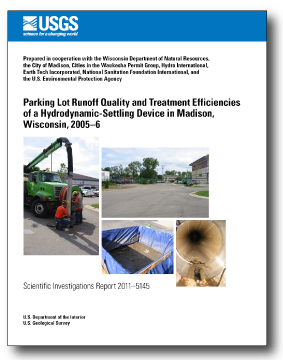Scientific Investigations Report 2011–5145
 AbstractA hydrodynamic-settling device was installed in 2004 to treat stormwater runoff from a roof and parking lot located at the Water Utility Administration Building in Madison, Wis. The U.S. Geological Survey, in cooperation with the Wisconsin Department of Natural Resources, the City of Madison, cities in the Waukesha Permit Group, Hydro International, Earth Tech, Inc., National Sanitation Foundation International, and the U.S. Environmental Protection Agency, monitored the device from November 2005 through September 2006 to evaluate it as part of the U.S. Environmental Protection Agency’s Environmental Technology Verification Program. Twenty-three runoff events monitored for flow volume and water quality at the device’s inlet and outlet were used to calculate the percentage of pollutant reduction for the device. The geometric mean concentrations of suspended sediment (SS), “adjusted” total suspended solids (TSS), total phosphorus (TP), dissolved phosphorus (DP), total recoverable zinc (TZn), and total recoverable copper (TCu) measured at the inlet were 107 mg/L (milligrams per liter), 92 mg/L, 0.17 mg/L, 0.05 mg/L, 38 ug/L (micrograms per liter), and 12 ug/L, respectively, and these concentrations are in the range of values observed in stormwater runoff from other parking lots in Wisconsin and Michigan. Efficiency of the settling device was calculated using the efficiency ratio and summation of loads (SOL) methods. Using the efficiency ratio method, the device reduced concentrations of SS, and DP, by 19, and 15, percent, respectively. Using the efficiency ratio method, the device increased “adjusted” TSS and TZn concentrations by 5 and 19, respectively. Bypass occurred for 3 of the 23 runoff events used in this assessment, and the bypass flow and water-quality concentrations were used to determine the efficiency of the bypass system. Concentrations of SS, “adjusted” TSS, and DP were reduced for the system by 18, 5, and 18, respectively; however, TZn increased by 5 percent. Some of the TSS concentrations were “adjusted” to add the particles that remained on the sieves during sample processing. The loads of SS, “adjusted” TSS, and DP were reduced using the SOL method for the settling device by 38, 9, and 19 percent, respectively, and TZn increased by 13 percent. For the bypass system, the loads of SS, “adjusted” TSS, and DP had percentage reductions of 39, 12, 22, respectively, however TZn increased by 4 percent. The SOL method produced percentage reductions for SS and “adjusted” TSS that were twice those for the efficiency ratio method. Removing the two large runoff events on August 23 and 24, 2006, from the SOL calculation brought the reduction for SS down to 16 and increased “adjusted” TSS by 4 percent. The two large runoff events were anomalies in that the runoff volumes and dissolved solids concentrations were greatly increased by overflow from an adjacent recycling facility. The SOL method was used to determine the percentage of SS load reduction for six different particle sizes for both the settling device and bypass system. Essentially no load reduction was observed for particles less than 125 micrometers (μm) in diameter, and about a 90-percent reduction occurred for particle sizes greater than 250 µm in diameter. The large removal efficiencies for particle sizes greater than 250 µm in diameter were further supported by the fact that more than 80 percent of the particle sizes trapped in the sump were greater than 250 µm in diameter. These results support the claim by the manufacturer of achieving a large percentage load reduction for particle sizes greater than 250 µm in diameter. |
First posted October 4, 2012 For additional information contact: Part or all of this report is presented in Portable Document Format (PDF); the latest version of Adobe Reader or similar software is required to view it. Download the latest version of Adobe Reader, free of charge. |
Horwatich, J.A., and Bannerman, R.T., 2012, Parking lot runoff quality and treatment efficiencies of a hydrodynamic-settling device in Madison, Wisconsin, 2005–6: U.S. Geological Survey Scientific Investigations Report 2011–5145, 35 p. plus 11 app., available only at http://pubs.usgs.gov/sir/2011/5145.
Abstract
Introduction
Site Description
Design of Hydrodynamic-Settling Device
Methods of Data Collection
Evaluation of Hydrodynamic-Settling Device
Summary
References
Appendix 1-11